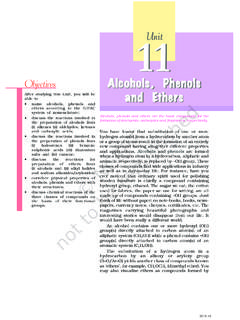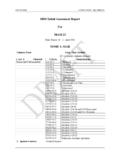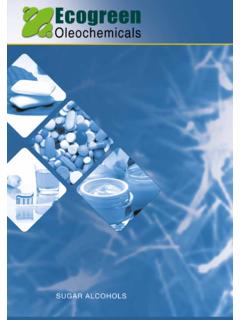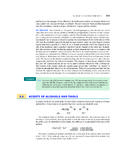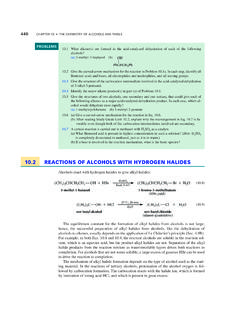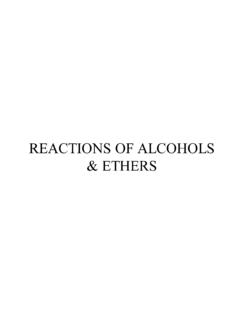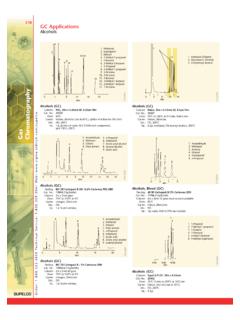Transcription of MATERIALS SAFETY DATA SHEET (MSDS) February …
1 MSDS Number NCP/P/1. MATERIALS SAFETY DATA SHEET . Version number Version (MSDS) Date issued 11th February 2016. Next Review date February 2018. ethanol (C2H5OH) Page No. Page 1 of 9. COMPANY DETAILS. Name : NCP Alcohols Emergency telephone No.: +27 (31) 579 2004. Address : 121 Sea Cow lake Road, Durban, 4001, South Africa Telephone : +27 (31) 560 1111. Fax : +27 (31) 579 2776. 1. Product and Company Identification (Page 1 may be used as an emergency SAFETY data SHEET ). Trade name : ethanol (Industrial, Absolute or Anhydrous, Chemical abstract No. : 64-17-5. Rum, Light Spirits, Extra Neutral Potable, Neutral Potable, Rectified Extra Neutral and Molecular Mass : 46,08. High Purity Extra Neutral Potable Alcohol). Chemical family : Aliphatic Alcohol NIOSH No. : KQ 6300000. Chemical name : ethanol Hazchem code : 2(S) E; 3(S) E. Synonyms : Ethyl Alcohol, See Trade name UN No. : 1170. 2. Composition: v Hazardous components : Ethyl Alcohol ( /v). EEC classification : 200 578 6 30. R Phrases : R11 (Highly Flammable).
2 3. Hazards Identification: Main Hazard : Harmful if swallowed or inhaled. Possible aspiration hazard if swallowed (can enter lungs and cause damage). May be irritating to the skin, eyes and respiratory tract. Over exposure may cause CNS depression. Possible reproductive hazard. Flammability : Flash Point 12 C. Extremely flammable liquid (R11). Ignition temperature 425 C. Chemical Hazard : ethanol is a flammable liquid whose vapours can form ignitable and explosive mixtures with air at normal room temperatures. Thus, an aqueous mixture containing 30% ethanol can produce a flammable mixture of 1. vapour and air at 29 C, and even one containing only 5% alcohol can produce a flammable mixture at 62 C. 2. ethanol reacts vigorously with a wide range of oxidizing MATERIALS and other chemicals . Disulphuryl Difluoride, Silver Nitrate, Bromine Pentafluoride, Potassium Perchlorate, Nitrosyl Perchlorate, Chromyl Chloride, Chloryl Perchloride, Uranyl Perchlorite, Chromium Trioxide, Fluorine Nitrate, Dioxygen Difluoride, Uranium Hexafluoride, Iodine Heptafluoride, Tetrachlorosilane, Permanganic acid, Nitric acid [the nitric acid 3,5.]
3 Fizz reaction used formally for cleaning laboratory glassware should not be used ], Hydrogen Peroxide, Peroxodisulphuric acid, Potassium Dioxide, Sodium Peroxide, Potassium Permanganate, Ruthenium (VIII). 6 7. Oxide, Platinum, Potassium , Potassium tert Butoxide, Silver Oxide and Sodium . MSDS Number NCP/P/1. MATERIALS SAFETY DATA SHEET . Version number Version (MSDS) Date issued 11th February 2016. Next Review date February 2018. ethanol (C2H5OH) Page No. Page 2 of 9. Biological Hazard : ethanol is rapidly oxidized in the body to acetaldehyde, then to acetate, and finally to carbon dioxide and 8, 9. water; un-oxidized alcohol is excreted in the urine and expired in the air. 26-28 29. Reproductive hazard : Some evidence of foetotoxicity and teratogenicity has been observed in experimental animals treated with high doses of ethanol during gestation. Alcohol may induce spontaneous abortions, may impair fertility, may cause harm to the unborn child and may cause harm to breast fed babies.
4 The reproductive hazards have been determined after repeated excessive consumption of ethanol ; these effects are not likely to occur through exposure below the Occupational Exposure Limits in the working environment. Health effects eyes : Moderately irritating. Exposure to liquid, vapours, fumes or mist may cause irritation. Direct contact may cause irritation, redness, pain, corneal inflammation and possible corneal damage. Health effects skin : Repeated or prolonged contact may result in defatting, redness, pain, itching, inflammation, cracking and possible secondary infection. Repeated skin contact may result in allergic skin reaction in a very small proportion of individuals. Health effects ingestion : Large doses lead to alcohol poisoning while repeated ingestion can lead to alcoholism. Alcohol abuse and 11-13. dependence can have a profound effect on work performance and tendency to accidents at work. The presence of denaturants, Methanol, pyridines, and benzene in industrial alcohol greatly increase the toxicity on ingestion.
5 ethanol drinking is also suspected of increasing the toxic effect of other chemicals 14. encountered in the laboratory and the workplace by inhibition of their metabolism or excretion ; 1, 1, 1. 15 16 17 18, 19. Trichloroethane , Xylene, Trichloroethylene and Dimethylformamide , Benzene and Lead. May cause harmful central nervous system effects. Effects may include excitation, euphoria, headache, dizziness, drowsiness, blurred vision, fatigue, tremors, convulsions, loss of consciousness, coma, respiratory arrest and death. Severe acute intoxication may cause Hypoglycaemia, Hypothermia and extensor rigidity. Prolonged or frequent contact may result in liver injury. Health effects inhalation : Intoxicating if continuously inhaled for a long period of time. Occupational Exposure Limits (8-hour reference 3 30. period) 1000ppm (1900mg/m ). Carcinogenicity : Long-term consumption of alcoholic beverages demonstrates an increase in the occurrence of breast cancer and colorectal cancer. Malignant tumours of the oral cavity, Pharynx, Larynx, Oesophagus and Liver is also causally 31 20, 21.
6 Related to the consumption of alcoholic beverages. Some studies have shown an excess incidence of laryngeal cancer over the expected from exposure to synthetic alcohol, with Diethyl Sulphate probably being the causative agent. 22. Mutagenicity : ethanol has been found to be non- mutagenic in the Salmonella microsome test, but some transient 23-25. mutagenic changes have been observed in male, but not female, mice treated with rather large doses. ethanol is mutagenic in man via its first metabolite, Acetaldehyde. Acetaldehyde induces chromosomal 32. aberrations, sister-chromatid exchanges and cross-links between DNA strands. Neurotoxicity : Over exposure may cause Central Nervous System (CNS) depression. 4. First aid Measures: Product in eye : Flush immediately with water or neutral saline solution for at least 15 minutes. Seek medical attention. Product on skin : Remove contaminated clothing and rinse contaminated area with soap and water. If skin irritation persists seek medical attention.
7 MSDS Number NCP/P/1. MATERIALS SAFETY DATA SHEET . Version number Version (MSDS) Date issued 11th February 2016. Next Review date February 2018. ethanol (C2H5OH) Page No. Page 3 of 9. Product ingested : If victim is conscious, give 1-3 glasses of water or milk to dilute stomach contents. If spontaneous vomiting occurs, or when vomiting is induced, monitor for breathing difficulty. Do not make an unconscious or semi . conscious person vomit. Keep affected person warm at rest. Get medical attention for substantial ingestions and/or gastrointestinal symptoms. Product inhaled : Remove the victim to fresh air. If not breathing, ensure open airway and institute cardiopulmonary resuscitation (CPR). If breathing is weak, irregular or has stopped apply artificial respiration. Oxygen may be beneficial. Keep affected person warm and at rest. Get immediate medical attention. 5. Fire fighting Measures: Extinguishing media : Use dry chemical, alcohol foam or carbon dioxide to extinguish fire. Water may be ineffective but should be used to cool fire- exposed containers, structures and to protect personnel.
8 If leak or spill has not ignited, ventilate area and use water spray to disperse gas or vapour and to protect personnel attempting to stop a leak. Use water to dilute spills and to flush them away from sources of ignition. Do not flush down public sewers or other drainage systems. Special hazards : Flammable Flash point : 12 - 16 C. v Flammability/explosion limits : 3, 3 19% /v Dangerous when exposed to heat or flame. Vapours form flammable or explosive mixtures with air at room temperature. Vapour or gas may spread to distant ignition sources and flash back. Run off to sewer may cause fire or explosion hazard. Containers may explode in heat of fire. Vapours may concentrate in confined areas. Irritating or toxic substances may be emitted upon thermal decomposition. Protective clothing : Exposed fire fighters should wear approved self-contained breathing apparatus with full face mask and full protective equipment. 6. Accidental Release Measures: Personal precautions : Protective clothing should be worn to prevent excessive skin contact.
9 Environmental precautions : Prevent liquid entering sewers. Do not allow to enter surface waters, storm drains, etc. Small spills : Take immediate steps to stop and contain the spill. Caution should be excised regarding personnel SAFETY and exposure to be spilled material. Eliminate all sources of ignition and wear protective clothing. Absorb small spills onto paper towels and evaporate in a safe place in a fume hood. Flush the contaminated area with plenty of water. Large spills : Stop leak if you can do it without risk. Contact your local fire department. Eliminate all sources of ignition and static; restrict access to area until completion of clean-up procedure. Wear adequate protective equipment, use self-contained breathing apparatus in confined poorly-ventilated areas. Large quantities should be absorbed on to sand, vermiculite or an equivalent absorbent material and removed to a safe area for disposal. Flush the contaminated area with plenty of water. Incineration is the recommended method of disposal.
10 MSDS Number NCP/P/1. MATERIALS SAFETY DATA SHEET . Version number Version (MSDS) Date issued 11th February 2016. Next Review date February 2018. ethanol (C2H5OH) Page No. Page 4 of 9. 7. Handling and Storage: Suitable material : ethanol is not corrosive to metals and may be stored in stainless steel, mild steel or aluminium containers. ethanol may also be stored in HDPE containers. Handling/. storage precautions : Ground lines and equipment used during transfer to reduce the possibility of static spark-initiated fire or explosion. Store in approved flammable liquid storage containers. Keep containers tightly closed as this material readily absorbs moisture. Store away from incompatible MATERIALS . Store in a cool, dry well- ventilated area away from sparks, flames and other sources of ignition. Eliminate all sources of static electricity. Use non sparking electrical and ventilation systems. Storage criteria: Flammable Liquid store 8. Exposure Control / Personal Protection: Occupational exposure limits : Country 8 Hour TWA Hygiene Limit STEL.




